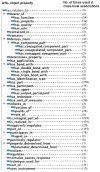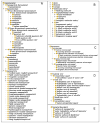NanoParticle Ontology for cancer nanotechnology research
- PMID: 20211274
- PMCID: PMC3042056
- DOI: 10.1016/j.jbi.2010.03.001
NanoParticle Ontology for cancer nanotechnology research
Abstract
Data generated from cancer nanotechnology research are so diverse and large in volume that it is difficult to share and efficiently use them without informatics tools. In particular, ontologies that provide a unifying knowledge framework for annotating the data are required to facilitate the semantic integration, knowledge-based searching, unambiguous interpretation, mining and inferencing of the data using informatics methods. In this paper, we discuss the design and development of NanoParticle Ontology (NPO), which is developed within the framework of the Basic Formal Ontology (BFO), and implemented in the Ontology Web Language (OWL) using well-defined ontology design principles. The NPO was developed to represent knowledge underlying the preparation, chemical composition, and characterization of nanomaterials involved in cancer research. Public releases of the NPO are available through BioPortal website, maintained by the National Center for Biomedical Ontology. Mechanisms for editorial and governance processes are being developed for the maintenance, review, and growth of the NPO.
Copyright © 2010 Elsevier Inc. All rights reserved.
Figures









Similar articles
-
Ontologies for cancer nanotechnology research.Annu Int Conf IEEE Eng Med Biol Soc. 2009;2009:4158-61. doi: 10.1109/IEMBS.2009.5333941. Annu Int Conf IEEE Eng Med Biol Soc. 2009. PMID: 19964619
-
BioPortal: enhanced functionality via new Web services from the National Center for Biomedical Ontology to access and use ontologies in software applications.Nucleic Acids Res. 2011 Jul;39(Web Server issue):W541-5. doi: 10.1093/nar/gkr469. Epub 2011 Jun 14. Nucleic Acids Res. 2011. PMID: 21672956 Free PMC article.
-
[Concepts of ontology-based neuroinformatics and their relations].Beijing Da Xue Xue Bao Yi Xue Ban. 2009 Apr 18;41(2):230-4. Beijing Da Xue Xue Bao Yi Xue Ban. 2009. PMID: 19377637 Chinese.
-
Controlled vocabularies and ontologies in proteomics: overview, principles and practice.Biochim Biophys Acta. 2014 Jan;1844(1 Pt A):98-107. doi: 10.1016/j.bbapap.2013.02.017. Epub 2013 Feb 19. Biochim Biophys Acta. 2014. PMID: 23429179 Free PMC article. Review.
-
The ontology life cycle: Integrated tools for editing, publishing, peer review, and evolution of ontologies.AMIA Annu Symp Proc. 2010 Nov 13;2010:552-6. AMIA Annu Symp Proc. 2010. PMID: 21347039 Free PMC article. Review.
Cited by
-
Guidelines for managing data and processes in bone and cartilage tissue engineering.BMC Bioinformatics. 2014;15 Suppl 1(Suppl 1):S14. doi: 10.1186/1471-2105-15-S1-S14. Epub 2014 Jan 10. BMC Bioinformatics. 2014. PMID: 24564199 Free PMC article.
-
A machine learning approach to identify clinical trials involving nanodrugs and nanodevices from ClinicalTrials.gov.PLoS One. 2014 Oct 27;9(10):e110331. doi: 10.1371/journal.pone.0110331. eCollection 2014. PLoS One. 2014. PMID: 25347075 Free PMC article.
-
Nanoinformatics: a new area of research in nanomedicine.Int J Nanomedicine. 2012;7:3867-90. doi: 10.2147/IJN.S24582. Epub 2012 Jul 24. Int J Nanomedicine. 2012. PMID: 22866003 Free PMC article.
-
Nanoinformatics workshop report: Current resources, community needs, and the proposal of a collaborative framework for data sharing and information integration.Comput Sci Discov. 2013;6(1):14008. doi: 10.1088/1749-4699/6/1/014008. Comput Sci Discov. 2013. PMID: 24454543 Free PMC article.
-
Transforming Cancer Nanotechnology Data Analysis and User Experience. Part I: Current Challenges and Solutions Provided by caNanoLab.Wiley Interdiscip Rev Nanomed Nanobiotechnol. 2025 Jul-Aug;17(4):e70030. doi: 10.1002/wnan.70030. Wiley Interdiscip Rev Nanomed Nanobiotechnol. 2025. PMID: 40826521 Free PMC article. Review.
References
-
- Blake J. Bio-ontologies - fast and furious. Nat Biotech. 2004;22:773–4. - PubMed
-
- Musen MA. Dimensions of knowledge sharing and reuse. Comput Biomed Res. 1992;25(5):435–67. - PubMed
-
- Gruber TR. A translational approach to portable ontology specifications. Knowl Aquis. 1993;5(2):199–220.
-
- Noy NF, McGuinness DL. Ontology development 101: a guide to creating your first ontology. Stanford Knowledge Systems Laboratory Technical Report and Stanford Medical Informatics Technical Report. 2001. Available from: Knowledge Systems Laboratory Stanford University. http://www.ksl.stanford.edu/KSL_Abstracts/KSL-01-05.html.
-
- Smith L, Wilbur WJ. Retrieving definitional content for ontology development. Comput Biol Chem. 2004;28(5-6):387–91. - PubMed
Publication types
MeSH terms
Grants and funding
LinkOut - more resources
Full Text Sources

